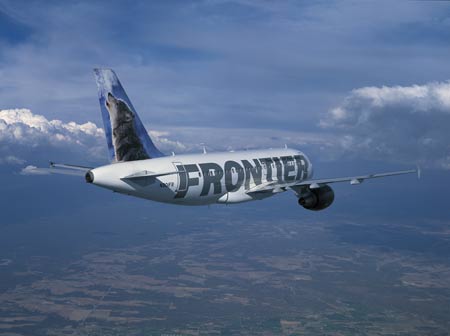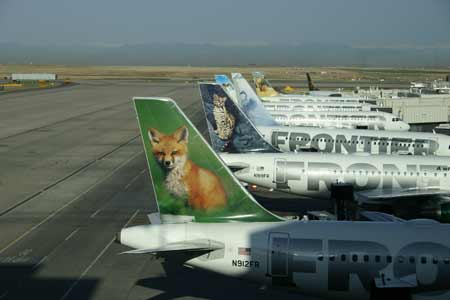Frontier Airlines is a creature of the west, a feature that is reflected throughout the business, from the aircraft to the people to the company culture
One of the Western features that Airline Business enjoyed on a visit to the snow-bound Rocky Mountains to meet chief executive Jeff Potter and his team was the airline's wildlife motifs (see picture). Animal life of found through the West marks the airline. Each plane has an animal in very large portrait on its tail or vertical stabiliser and winglets of the carrier's all-Airbus fleet. Furry folks include Larry the Lynx, Grizwald the Bear, Foxy the Fox and Jack the Rabbit. Larry is a popular guy, because the airline has even named its new feeder service, Lynx, after him. Marine life also flies with Flip the Bottle-nosed Dolphin, and Joe, Jim, Jay and Gary, the Penguins. You can meet these guys and see them tell their tails, er tales, because they also act as spokescreatures for the airline. Frontier's website has details on the family, er pack, and some of their ads.
YouTube also picks up many of the Frontier ads, including the penguins, who sing as a quartet. Frontier now has 50 beasts in its bestiary, plus another 10 on the Canadair regional jets that fly as Frontier JetExpress. JetExpress will begin adding Embraers this spring, which will make for some interesting changes.
 The airline's chief executive, Jeff Potter, Airline Business's cover executive for March 2007, is also very much a westerner. He grew up in the Pacific Northwest and his first job was on the graveyard shift, cleaning airliners for the old Frontier Airlines in Spokane, the only big town in eastern Washington State and still a major transportation hub in those parts. Jeff moved up to a customer-service position and then worked for other airlines, including California-based Pacific Southwest Airlines, the old PSA that was known among flyers for the smile painted in a curved line across the nose of each its planes.
The airline's chief executive, Jeff Potter, Airline Business's cover executive for March 2007, is also very much a westerner. He grew up in the Pacific Northwest and his first job was on the graveyard shift, cleaning airliners for the old Frontier Airlines in Spokane, the only big town in eastern Washington State and still a major transportation hub in those parts. Jeff moved up to a customer-service position and then worked for other airlines, including California-based Pacific Southwest Airlines, the old PSA that was known among flyers for the smile painted in a curved line across the nose of each its planes.
One of Jeff's most recent forays into the public arena was also western. It was on the back of a mechanical bull in a cowboy-themed club to raise bucks for children's charity. Under the sobriquet of "Naughty by Nature Jeff", Potter raised more money than other Denverites by staying on the bouncing machine longer than them.
Jeff joined the new Frontier Airlines shortly after it was founded in 1994 and the rest is history. Like many at Frontier, he has fond memories of the old Frontier, a carrier that was a major presence throughout the West through the 1950s and up until 1986, when it was shut down by its new owners. People Express had just bought Frontier, dashing hopes that United would buy it. The former Frontier still has a following of former employees and aircraft-lovers who remember its large fleet of Convairs. Some of Frontier's former employees maintain a site with memorabilia and memories.

Of course, the new Frontier has made news of its own since Airline Business visited. It's moved ahead on the new Embraer network that Republic Airways will fly for it, and its pilot group, represented by the Frontier Airlines Pilots Association, ratified a new four-year contract by a 67% vote. Perhaps most interestingly, Frontier has moved into a fortress hub of a legacy carrier. In May 2007, Frontier begins service at Memphis, a Northwest Airlines bastion, with two daily Denver flights and frequencies between Memphis and both Las Vegas, to the west, and Orlando, to the east. This is the first low-cost service that Memphis has had and represents a victory for the city's quest for airlines to compete with Northwest. It puts Frontier in-between two cities - Nashville, Tennessee, to the east and Little Rock, Arkansas, to the west - that have Southwest service and that have seen passengers driving from Memphis for the low fares. After all, Frontier does nothing that's not thought out very carefully.
About 72 hours after Jeff went to Memphis to announce the new service in that Northwest Airlines-dominated city, Northwest came out with some news of its own: it too had some ideas for new Memphis service. It will beef up its Denver service to Airbus A319 and A320 services instead of its three daily 50-seat CRJ flights, starting in June.
And Northwest is increasing frequencies on services between Memphis and Las Vegas and Orlando, plus Seattle and a new Indianapolis route thrown in for good measure. Las Vegas goes up to two daily flights and Orlando to four in May, while the Seattle service becomes daily double and the Hoosier flights will be daily by June. And flyers will get double miles on all the routes for the next few months. The outcome could go either way: the two carriers will just bleed each other or everyone wins.

George Hamlin, the transportation consultant, says that this Memphis move may be as money-losing for Frontier as its attempt to set up an operation in Los Angeles. "Trying to compete with a carrier at one of its hubs is a good way to lose money quickly," he says.
Growth alone will not be enough to fend off AirTran, however: the southern challenger is not shy. AirTran has sued to overturn some of the Midwest defences and is also making an appeal to public sentiment. Midwest is meeting the challenge with strong backing from state officials. AirTran recently made a very public vow that it would make Milwaukee the centre of the universe or at least build it up enormously if it wins. AirTran has argued from the very beginning that Milwaukee is underserved and that Midwest’s recent prosperity is largely the result of a pull down in Milwaukee by Northwest Airlines, which had kept fares down and competition steep. AirTran said it would add 74 daily flights at the Mitchell airport in Milwaukee, adding 29 destinations to the 41 Midwest now serves with its 144 daily departures. It would hire about 1,100 extra employees in Wisconsin, adding a payroll of about $30 million annually and creating an economic impact of nearly $1 billion for the state. You can read the AirTran plan in a Securities and Exchange Commission filing (click on form 425).
Northwest did pull back in Milwaukee: Raymond James & Associates securities analyst Buck Horne estimates that during the first quarter of last year, Northwest capacity at Milwaukee on competing routes fell by 46% year-on-year and that by next month it will have fallen 18% year-on-year on competing routes and about 5% in all, while Midwest capacity will be up by 2% next month.
In response, Midwest has gone public with some arguments it had been making in private with investors. Milwaukee is not underserved, it says, and the AirTran promises of added service there are part of “a trail of broken promises”. Midwest argues that AirTran has left 29 markets it has promised to serve in the past three years, abandoning some or just pulling back. It claims that AirTran’s schedule changes at Dallas/Fort Worth (from a planned 30 daily flights to eight), Washington Dulles (from 16 to seven daily flights) and Pittsburgh (from 13 to six) are good examples of AirTran's cuts. And in any event, the Milwaukee operation, if AirTran follows through on all of its plans, would have more flights than AirTran’s Atlanta Hartsfield operations, which are at a much bigger airport in a much bigger market. Midwest’s formal response is here (click on form 14 D9/A).
Click here for the original interview with Jeff Potter (22 February 2007)
Interview with Jeff Potter (6 June 2006)
Source: Airline Business























